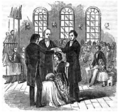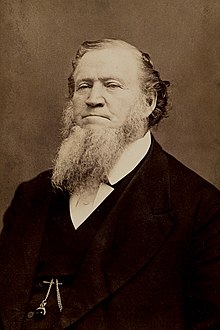|
Welcome to the portal of The Latter Day Saint movement
Introduction The Latter Day Saint movement (also called the LDS movement, LDS restorationist movement, or Smith–Rigdon movement) is the collection of independent church groups that trace their origins to a Christian Restorationist movement founded by Joseph Smith in the late 1820s. Collectively, these churches have over 17 million nominal members, including over 17 million belonging to the Church of Jesus Christ of Latter-day Saints (LDS Church), 250,000 in the Community of Christ, and several other denominations with memberships generally ranging in the thousands of members. The predominant theology of the churches in the movement is Mormonism, which sees itself as restoring again on Earth the early Christian church; an additional doctrine of the church allows for prophets to receive and publish modern-day revelations. A minority of Latter Day Saint adherents, such as members of Community of Christ, have been influenced by Protestant theologies while maintaining certain distinctive beliefs and practices including continuing revelation, an open canon of scripture and building temples. Other groups include the Remnant Church of Jesus Christ of Latter Day Saints, which supports lineal succession of leadership from Smith's descendants, and the more controversial Fundamentalist Church of Jesus Christ of Latter-Day Saints, which defends the practice of polygamy. (Full article...) General images -The following are images from various Latter Day Saint movement-related articles on Wikipedia.
Selected article Blood atonement was a doctrine in the history of Mormonism still adhered to by some fundamentalist splinter groups, under which the atonement of Jesus does not redeem an eternal sin. To atone for an eternal sin, the sinner should be killed in a way that allows his blood to be shed upon the ground as a sacrificial offering, so he does not become a son of perdition. The largest Mormon denomination, the Church of Jesus Christ of Latter-day Saints (LDS Church), has denied the validity of the doctrine since 1889 with early church leaders referring to it as a "fiction" in spite of evidence to the contrary and later church leaders referring to it as a "theoretical principle" that had never been implemented in the LDS Church. The doctrine arose among early Mormon leaders and it was significantly promoted during the Mormon Reformation, when Brigham Young governed the Utah Territory as a near-theocracy. According to Young and other members of his First Presidency, eternal sins that needed blood atonements included apostasy, theft and fornication (sodomy and adultery were two sins that did not need blood atonements). (Full article...)Selected locationThe Nauvoo Temple was the second temple constructed by the Church of Jesus Christ of Latter Day Saints. The church's first temple was completed in Kirtland, Ohio, United States, in 1836. When the main body of the church was forced out of Nauvoo, Illinois, in the winter of 1846, the church attempted to sell the building, finally succeeding in 1848. The building was damaged by arson and a tornado before being demolished. In 1937, The Church of Jesus Christ of Latter-day Saints (LDS Church) reacquired the lot on which the original temple had stood. In 2000, the church began to build a temple on the original site with an exterior that is a replica of the first temple, but whose interior is laid out like a modern Latter-day Saint temple. On June 27, 2002, a date that coincided with the 158th anniversary of the death of Joseph and Hyrum Smith, the temple was dedicated by the LDS Church as the Nauvoo Illinois Temple. (Full article...)
Selected schismatic historiesThe Church of Jesus Christ of Latter-day Saints, informally known as the LDS Church or Mormon Church, is a restorationist, nontrinitarian Christian denomination that is the largest denomination in the Latter Day Saint movement. The church is headquartered in the United States in Salt Lake City, Utah and has established congregations and built temples worldwide. According to the church, it has over 17 million members and over 99,000 volunteer missionaries. The church was the fourth-largest Christian denomination in the United States as of 2012, and reported over 6.8 million US members . The church was founded as the Church of Christ in western New York, in 1830 by Joseph Smith during the Second Great Awakening. Under Smith's leadership, the church's headquarters moved successively to Ohio, Missouri, and Illinois. After Smith's 1844 death and a resultant succession crisis, the majority of his followers sided with Brigham Young, who led the church to its current headquarters in Salt Lake City. Young and his successors continued the church's growth, first throughout the Intermountain West, and more recently as a national and international organization. (Full article...)OutlinesRelated portalsKey biographies
Brigham Young (/ˈbrɪɡəm/; June 1, 1801 – August 29, 1877) was an American religious leader and politician. He was the second president of the Church of Jesus Christ of Latter-day Saints (LDS Church) from 1847 until his death in 1877. During his time as church president, Young led his followers, the Mormon pioneers, west from Nauvoo, Illinois, to the Salt Lake Valley. He founded Salt Lake City and served as the first governor of the Utah Territory. Young also worked to establish the learning institutions that would later become the University of Utah and Brigham Young University. A polygamist, Young had at least 56 wives and 57 children. He formalized the prohibition of black men attaining priesthood, and led the church in the Utah War against the United States. (Full article...)
Selected image The Red Brick Store in Nauvoo, Illinois. Constructed and owned by Joseph Smith, Jr., it became a center of economic, political, religious, and social activity among the Latter Day Saints.
Did you know (auto generated)
Selected Anniversaries
Selected quote
TopicsFeatured contentCategoriesWikiProjectsAssociated WikimediaThe following Wikimedia Foundation sister projects provide more on this subject:
Discover Wikipedia using portals | ||||||||||





































